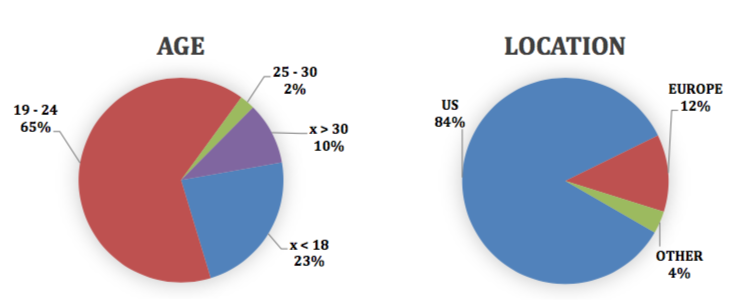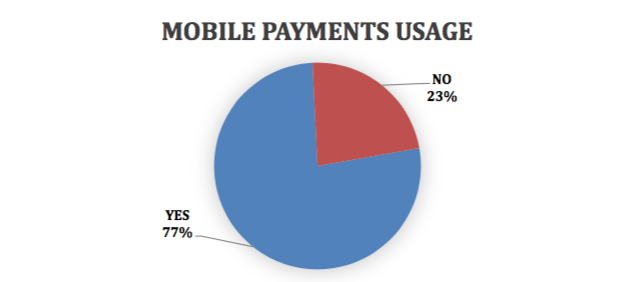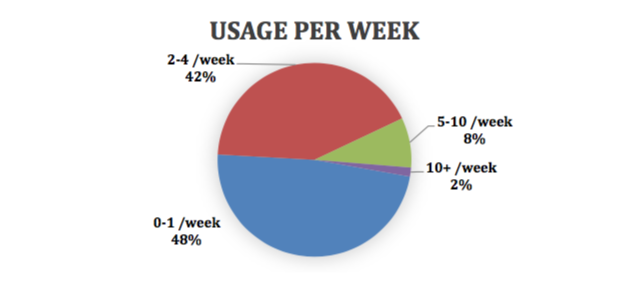Guest post contributed by Warren Fisher of Manole Capital Management, LLC. You can read Part 1 here and Part 2 here.
In January and February of 2018, Manole Capital conducted a financial services survey specifically targeting the thoughts and opinions of millennials. Over 175 individuals participated, with nearly 90% under the age of 24 years old. 65% were between the age of 19 and 24 and 23% were 18 or younger. In terms of demographics, 84% were from the United States and 12% were from Europe. For additional information about our survey audience, please contact Manole Capital directly.

Series #3: Mobile Payments
The modern smartphone is a remarkable invention. An all-encompassing device that fits in your pocket, it can seamlessly do all the tasks that once required separate technologies. It is estimated that 68% of the US population has a smartphone and 3⁄4 of Amerian households. These figures are significantly higher than the 2012 penetration rate of only 40%. US smartphones stand at roughly 225 million, which represents less than 10% of the 2.3 billion globally.
In 2016, Facebook reported that the average amount of time users spent each day on its sites was over 50 minutes. While that might not sound like much, it is a staggering amount of time per person for their waking hours. With 24 hours in a day and an average of over 8 hours of daily sleep, 50 minutes represents over 6% of their awake hours.
Phones have an immense amount of capabilities and their applications of use are growing each day. The camera and video industries are essentially dead, as our smartphones are quite capable of handling the vast array of photos and videos we wish toshoot. Itwasonlyamatteroftimebeforethepaymentsindustrybegantothinkofbetterwaystoutilizeadvancingtechnology and this wonderful device. The growing importance of the smartphone as the go-to computing device for every digital activity is the goal. Why not incorporate mobile payments and wallet technology into this powerful (always present) device?
Phones as Wallets
Unfortunately for us, our wallet continues to look like George Costanza from the hit TV show Seinfeld.

Today, for everyday transactions, the plastic cards in your wallet still matter, and for many, cash and check remain a regular payment medium. With advances in smartphone technology, the traditional wallet is likely to change. We believe this transformation will occur over the next 5 to 10 years and payment apps will proliferate on our smartphones. We do not believe people will want to clutter their beautiful iPhone’s with 25 to 30 different payment apps. In our opinion, only a few, key payment networks will win this valuable real estate, as well as a select group of merchants.
P2P vs Mobile Payments
To differentiate, we consider mobile payments the use of one’s smartphone to pay for a good or services, either online or at a physical store. P2P or peer-to-peer payments represent using an app on your phone to pay a friend for a lost bet, split a lunch bill or any other casual payment (historically paid via cash). While P2P is a $35 billion industry right now, it is expected to grow to over $300 billion over the next 3 to 5 years.
For the first time ever, during the 2017 holiday shopping season, mobile payments represented more than half of all US eCommerce payments. In addition, and also for the first time, eCommerce was over half of all holiday season retail spending. Not only is eCommerce growing and gaining market share, but both P2P and mobile payments are becoming more widespread.
Amazon with WholeFoods
In July of 2017, we wrote an extensive article on why we thought Amazon purchased WholeFoods. Titled “Checkout Amazon”, it is our opinion that the main theme behind the transaction for altering the entire payment process for physical merchants. To read that note, click here or visit our website at www.manolecapital.com, under the “Research” tab.
Using Mobile Payments
Our first survey question on this topic simply attempted to understand if millennials were using mobile payment services. Not surprisingly, over 3⁄4’s of millennials are mobile payment users. We would have expected this number to be even higher, but not all millennials are early adopters.

Our next question wanted to understand how comfortable millennials were solely relying on their mobile phones for all of their payment services. As you can see, for those users of mobile payments, the vast majority of millennials would not be comfortable solely relying on mobile payments. Maybe they worry about having a charge on their phone that would enable it to get used or maybe others do not have their phones with them at all times. While mobile payment usage is high, it seems to be only one service used and not the dominant or most prevalent payment option. Interesting…

Usage
We are clearly in the early innings of mobile payments and its growth cycle. We will not be surprised to see massive growth in both of these categories, not only for months or quarters, but for years to come. As of today, it sure seems like mobile payments are still in their infancy. 1⁄2 of our surveyed millennials, whom are probably the greatest users of mobile payments, are using it only 1x per week. With 90% of our surveyed millennials under 4 mobile payments per week, either it is not readily accepted at physical locations or the product is still in the test versus best use stage.

Which Mobile Payment Service Is Winning?
For those using mobile payments, we then wanted to understand which service had the early lead. As you can clearly see, Venmo is the winner with 67% market share. What many people do not fully understand is that PayPal owns Venmo, so combining
Venmo with PayPal would be over 80% of our millennials choice for preferred mobile payment option. has to factor into PayPal’s current valuation.

PayPal
We wrote an extensive article on PayPal and its Venmo peer-to-peer payment application back in September of 2016. To read that note, click here or visit our website at www.manolecapital.com, under the “Research” tab.
As a shareholder of PayPal, we are pleased that it is currently leading the pack. The competition is fierce, and their peers are well-capitalized and eager to steal market share. If you’d like, click here for a 4 minute and 42 second video on this very topic, from Dan Schulman, PayPal’s CEO (in January).
Mobile Payments & P2P Conclusions:
From our survey we can conclude several things. First, millennials are leaning towards Venmo as their favorite P2P product. Now that PayPal has the early lead, the challenge will be to take advantage of this lead and get broader acceptance and usage. Venmo is a free service, so PayPal is not earning any revenue or profits from this market share lead. Can PayPal get Venmo accepted at physical locations and online for eCommerce transactions? If it is able to accomplish that, it will be able to monetize its great positioning.
Secondly, mobile payments and P2P are still in their test phase. Millennials are not embracing the product to the point where they will bypass more traditional forms of payments. At least not yet…
Our last survey will focus on millennials usage of brokerage accounts, bitcoin, and overall thoughts on cryptocurrencies.
Disclaimer:
Firm: Manole Capital Management LLC is a registered investment adviser. The firm is defined to include all accounts managed by Manole Capital Management LLC. In general: This disclaimer applies to this document and the verbal or written comments of any person representing it. The information presented is available for client or potential client use only. This summary, which has been furnished on a confidential basis to the recipient, does not constitute an offer of any securities or investment advisory services, which may be made only by means of a private placement memorandum or similar materials which contain a description of material terms and risks. This summary is intended exclusively for the use of the person it has been delivered to by Warren Fisher and it is not to be reproduced or redistributed to any other person without the prior consent of Warren Fisher. Past Performance: Past performance generally is not, and should not be construed as, an indication of future results. The information provided should not be relied upon as the basis for making any investment decisions or for selecting The Firm. Past portfolio characteristics are not necessarily indicative of future portfolio characteristics and can be changed. Past strategy allocations are not necessarily indicative of future allocations. Strategy allocations are based on the capital used for the strategy mentioned. This document may contain forward-looking statements and projections that are based on current beliefs and assumptions and on information currently available. Risk of Loss: An investment involves a high degree of risk, including the possibility of a total loss thereof. Any investment or strategy managed by The Firm is speculative in nature and there can be no assurance that the investment objective(s) will be achieved. Investors must be prepared to bear the risk of a total loss of their investment. Distribution: Manole Capital expressly prohibits any reproduction, in hard copy, electronic or any other form, or any re-distribution of this presentation to any third party without the prior written consent of Manole. This presentation is not intended for distribution to, or use by, any person or entity in any jurisdiction or country where such distribution or use is contrary to local law or regulation. Additional information: Prospective investors are urged to carefully read the applicable memorandums in its entirety. All information is believed to be reasonable, but involve risks, uncertainties and assumptions and prospective investors may not put undue reliance on any of these statements. Information provided herein is presented as of December 2015 (unless otherwise noted) and is derived from sources Warren Fisher considers reliable, but it cannot guarantee its complete accuracy. Any information may be changed or updated without notice to the recipient. Tax, legal or accounting advice: This presentation is not intended to provide, and should not be relied upon for, accounting, legal or tax advice or investment recommendations. Any statements of the US federal tax consequences contained in this presentation were not intended to be used and cannot be used to avoid penalties under the US Internal Revenue Code or to promote, market or recommend to another party any tax related matters addressed herein.


Leave a Reply